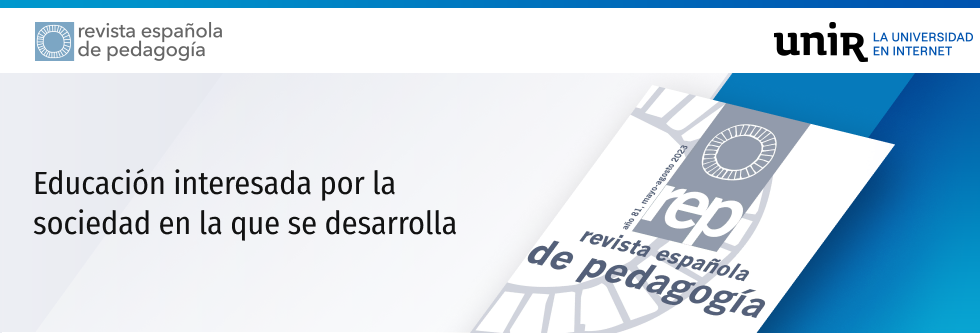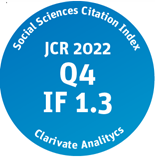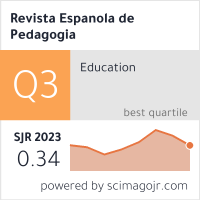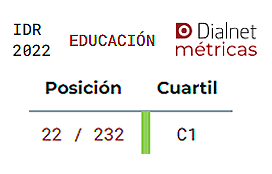Vol. LXXV (2017) - No. 266 El futuro de los MOOC: retos de la formación online, masiva y abierta [The future of MOOCs: Challenges for massive, open, online training].
Resumen
The various editions of the Horizon Report, led by the New Media Consortium and Educause, collate studies about the future use of technology and coming educational trends in various countries. The ninth edition of this report examines the impact of MOOC (Massive Open Online Courses) training platforms on the current educational landscape. Faced with the need for lifelong training of human capital in the knowledge society setting, efforts are being made in the educational sphere to boost, promote, and reactivate the development and economic growth of countries by using technology as an effective instrument for helping to teach literacy to the population and democratise knowledge. Consequently, taking a technological and innovative approach in higher education and occupational training and pre-university education, it is important to make the most of Web 2.0 resources and create new learning scenarios through virtual communities for social construction of knowledge from a cooperative, pedagogical, and inclusive perspective. Accordingly, the work discussed here considers the work- ings of MOOCs, the philosophy of which should be aimed at meeting the educational needs of contemporary society by offering new informal and non-formal learning scenarios that serve all citizens and have a democratic focus to eradicate the digital and social divide. The most signifi features of the book’s seven chapters are set out below. ,
The opening chapter presents the defining features of the MOOC phenomenon along with the identifying features of these platforms. The different types of online educational platforms are analysed and, from a variety of approaches, a critique is made of the current training model in place from an economic perspective, as well as of the didactic and pedagogic aspects that comprise and support it. The chapter ends by offering an in-depth analysis of the main challenges that must be faced to guarantee their sustainability, alluding to a practical proposal about sMOOCs (sustainable MOOCs), the aim of which is to overcome the limitations MOOCs have shown up to now. ,
Chapter two considers one of the main challenges the MOOC movement must confront: finding a sustainable economic model. An overview is provided of the current dominant economic models as well as an analysis of the advance of the evaluation and experimentation systems, raising questions such as whether MOOCs should charge for certification or extra course content, or instead propose an open model but charge for complementary services, such as tutoring. Furthermore, it considers the possibility of exploiting the analysis obtained and derived from the thousands of students who join the platforms, or even through including advertising in this type of social environment. The chapter ends with a series of economic options aimed at ensuring the sustainability of these platforms so that they continue to be freely available and accessible to all. ,
Chapter three uses a cooperative and open position to refer to the connectivist paradigm that must support MOOCs to encourage learning based on professional competences among the students. To do this, a change in student and teacher roles is needed, with teachers providing tutoring as a key element in the educational process to make possible constructive, autonomous, and meaningful learning by students. The chapter concludes by setting out the advantages and disadvantages of MOOCs in the view of experts. ,
Chapter four provides an overview of current and future technological models and their application to MOOCs. It emphasises the importance of new digital learning strategies for the immediate future through content curators, online comments, information categorisation and filtering programmes (recommendation systems), learning algorithms, multiplatform systems, intelligent and self-adapting tutorial systems, robots, and new virtual self-evaluation models. It ends with a proposal for didactic design in MOOCs that emphasises the utility of interactive learning activities. ,
Chapter five takes article 26 of the Universal Declaration of Human Rights, which states that every human being has the right to an education, as its starting point. The chapter’s aim is for MOOCs to act as a mechanism for closing the digital and social divide, thus making possible true democratisation of knowledge. Consequently, starting from the basic features of MOOCs as massive, open, accessible, and free training platforms, and bearing criteria of sustainability in mind, access to these courses should allow for multilingualism, multiculturalism, and people with functional diversity. Furthermore, it underlines the potential of smartphones and BYOD (bring your own device) initiatives, from a pedagogical perspective and for alleviating shortcomings in technological facilities in educational centres owing to lack of funds. Following a series of studies, conclusions are reached that focus on the possibility of universally extending an online training mode in different socioeconomic and cultural settings by using mobile devices as a resource to enable better accessibility for disadvantaged or developing people and settings. The models of attention for people with functional diversity in terms of accessibility are then considered, and the chapter ends by reviewing MOOCs in non-university education such as occupational and business training settings. ,
Chapter six expands on the main indicators that can be used to measure the quality of MOOC courses, the national and international bodies charged with measuring, aspects of standardisation in mass settings, and the certification and regulations in place for online education in the Spanish setting. It also summarises different pieces of research published in high-impact academic journals to establish what type of analysis and results are being obtained in research into the quality of MOOCs. ,
Finally, chapter seven sets out the most significant features of the MOOC movement since its appearance in Spain in 2012, its current position in higher education, and the best-established models at present. The institutions that have implemented MOOC-based educational provision in higher education are considered, a list of website addresses and search engines for courses in this format is given, and finally a study of the MOOC platforms most frequently used by Spanish universities is provided. ,
In conclusion, this work offers an in-depth analysis of the MOOC phenomenon and their importance in the field of higher education, concentrating on the desirability of establishing a type of MOOC based on connectivist and constructivist models where students play a key role in jointly constructing knowledge, promoting a type of autonomous, collaborative, cooperative, participative, and ubiquitous online learning where the teacher acts as a tutor. Consequently, the implementation and effectiveness of MOOCs does not so much rely on increas- ing the number of them but on achieving a pedagogical aim regarding quality that encourages new virtual learning environments where participants, with a Web 2.0 attitude, are interconnected, beyond the economic, institutional, or technological aspects on which the current debate focusses. ,
Noelia Margarita Moreno Martínez ■
Citación recomendada | Recommended citation
Martínez, N. (2023) . Vol. LXXV (2017) - No. 266 El futuro de los MOOC: retos de la formación online, masiva y abierta [The future of MOOCs: Challenges for massive, open, online training].. Revista Española de Pedagogía(1). https://www.revistadepedagogia.org/rep/vol0/iss1/41
Licencia Creative Commons | Creative Commons License
Esta obra está bajo una licencia internacional Creative Commons Atribución-NoComercial 4.0.
This work is licensed under a Creative Commons Attribution-NonCommercial 4.0 International License







Commentarios | Comments
Vázquez-Cano, E., López-Meneses, E. and Barroso, J. (2015).